Hello,
It is time. STOMPY TIME!
If you don't want spoilers on enemies and want to discover them naturally then you might want to skip this one.
Let's continue the story from FFF-413.
A trumpeting scream quietens all the small animals. You hear the breaking of waves followed by stomping: earth-shaking steps that are getting louder and louder.
Looking in the direction of the sound, you see a cliff rising to a tall hill. The fungus at the top shakes a little with each stomp, but the source is somewhere further behind the hill. You ready your weapons, but the sound stops getting louder and instead moves to the right, then gradually fades into the distance. Whatever it was, it was big.
After climbing the hill to investigate, you see a valley on the other side.
Some large translucent green eggs float on a raft of slimy foam in a pool of shallow water.
You get closer. The eggs are soft like jelly, the portion above water sagging under their own weight.
In the centre is a dark blurry mass of... tangled limbs and eyes.
Suddenly the egg erupts and a clawed limb swipes at your face. A strange creature wriggles around in the water trying to claw at you, and through the splashing you make out 5 limbs like a starfish. A bulging head-like structure has many eyes on one side and a sponge-like material on the other. On the sides of its head are crests of transparent blisters that are inflating with air to form something like a paddle or wing. It drags itself around like some sort of ravenous tentacled baby. With the occasional lurching movement it launches itself at you, trying to grapple you with its limbs and bite you with its underside.
The claws glance off your energy shield with minimal damage. Your personal laser defence springs into action and in a flash of light the newborn is cut to shreds. The laser then switches targets to the egg raft. A few moments later all the eggs burst into a horrifying swarm of angry thrashing creatures. The sea of flailing limbs and odd movement makes it difficult to target individuals. You bravely retreat back to the cliff and equip the flamethrower to protect yourself with a wall of fire. The undaunted wriggling creatures run straight into the fire and die soon after.
Another trumpeting scream pierces the sky but this time it doesn't sound distant at all. A slender towering creature stares straight at you with its large bulging eyes. It strafes sideways circling you, gracefully stepping over cliffs and tree-like fungi with its 5 thin legs. It launches something from its head, a projectile high into the air and arcing toward you. You start retreating, but 4 wings spring from the sides of the projectile and it steers towards you like a homing missile.
The flying creature rams into you, grappling you with its clawed limbs and slowing your movement. You throw it down to the ground and it becomes indistinguishable from the Wriggler you dispatched earlier. Your laser defences make short work of it, but without warning, you're struck by another projectile creature from the other side. Another Strafer has arrived and is also bombarding you. Both Strafers are staying out of range of your automated laser.
You dash towards one of the Strafers with your submachine gun in hand, but as you do the Strafer to your front retreats and the other advances. They seem intent on keeping you at range, constantly circling while flinging homing projectiles. No matter, you have another weapon up your sleeve. You dash forwards again, this time with a rocket launcher in hand. A rocket snakes its way through the air and blasts its way into the first Strafer. The creature shrieks and attempts to retreat, but another rocket is already on its way. The second rocket strikes unerringly and a moment later, the Strafer is blown apart leaving a cloud of pieces to rain down on the swamp below.
Stomp stomp stomp. The stomping has returned. A colossal spiked shell rises into view from behind a hill. It strides effortlessly over a cliff with its 5 huge armour-plated legs. This creature is clearly related to the others, but it is far heavier with a wide stance and thick legs. The central body or head region is like a shielding shell with small eyes peering through narrow holes.
You fire some rockets at the Stomper and they do some damage, but nowhere near enough to take it down. You have very few rockets left and they won't be enough to kill the Stomper so it's better to save them for the other Strafer (which is difficult to catch otherwise). The Stomper charges towards you. Even with your exoskeleton equipment the Stomper can outrun you. You stand your ground with the submachine gun but you can't dodge effectively while you fire. As it gets close the tremors stress your shield, and thrown debris from its stomps pummel the shields further. The creature lands a foot directly on you and your shields falter. That hurt. This isn't working.
You start moving again, not to outrun it but to outmanoeuvre it. It may be faster than you in a straight line, but it can't change directions as quickly. The other Strafer is still alive and flinging new enemies at you from a distance. By switching between dodging movement and bursts of SMG fire, you're able to evade most of the Stomper's damage and keep the number of Wrigglers low enough to not get overwhelmed. You wait for an opening when you're not being stomped on, swarmed, and the Strafer is in view. Away go the last 2 rockets and... success. The last Strafer falls dead.
Now it's just you and the Stomper. A duel to the death. While continuing to dodge its feet, you make your way to a larger area of land to make your last stand. No more rockets. Gun ammo is low. Time for the flamethrower to shine. As you circle each other, you douse the arena in flames. The dance continues in flames until one of you falls. More fire, more spinning, more fire! The world becomes a hazy blur of flames, smoke, and death.
The new enemies on Gleba are Pentapods, 5-legged creatures. They are based on distant relatives of starfish or seastars, so sometimes we call them starfish, landstars or starfeet. Mostly though, we call them by their most common forms of Stompers, Strafers, and Wrigglers.
When you first encounter the pentapods, it could be that you rushed to space, went straight to Gleba, and are very weak in combat. At the other end of the spectrum, this could be your third new planet and you could have spent a long time investing in military technology, including new weapons from other planets. This range of combat capability makes it difficult to choose a good starting threat level of the enemies. For now we're going for a threat level that makes the starting evolutions difficult if you are completely unprepared, but still survivable if you have standard equipment even if it's lacking in damage upgrades. Also if you are completely unprepared that just means the enemies are difficult to take down on your own, but then, an engineer with a pocket full of turrets never needs to be solo.
One of the reasons we can risk the pentapod enemies starting with better combat capability than biters is because they are fairly passive. They will defend their nests and attack you if you attack a nearby ally, but otherwise they will leave you alone - at first. If you do fight them and win then they will evolve.
Pollution on Gleba is different. The usual pollution sources aren't a problem for Gleba's ecosystem, it's already a high CO2 environment and the fungi would eat up most industrial pollutants. Instead Gleba's pollution mechanic is based on aroma and spores. The fungi that you need to grow, harvest and process are the same ones that the enemies eat. The agriculture activities make spores and smells that eventually attract the Pentapods. Also, as with Nauvis pollution, the effect does cause the local enemies to evolve as they are exposed to your agricultural growth formula and meddling ways.
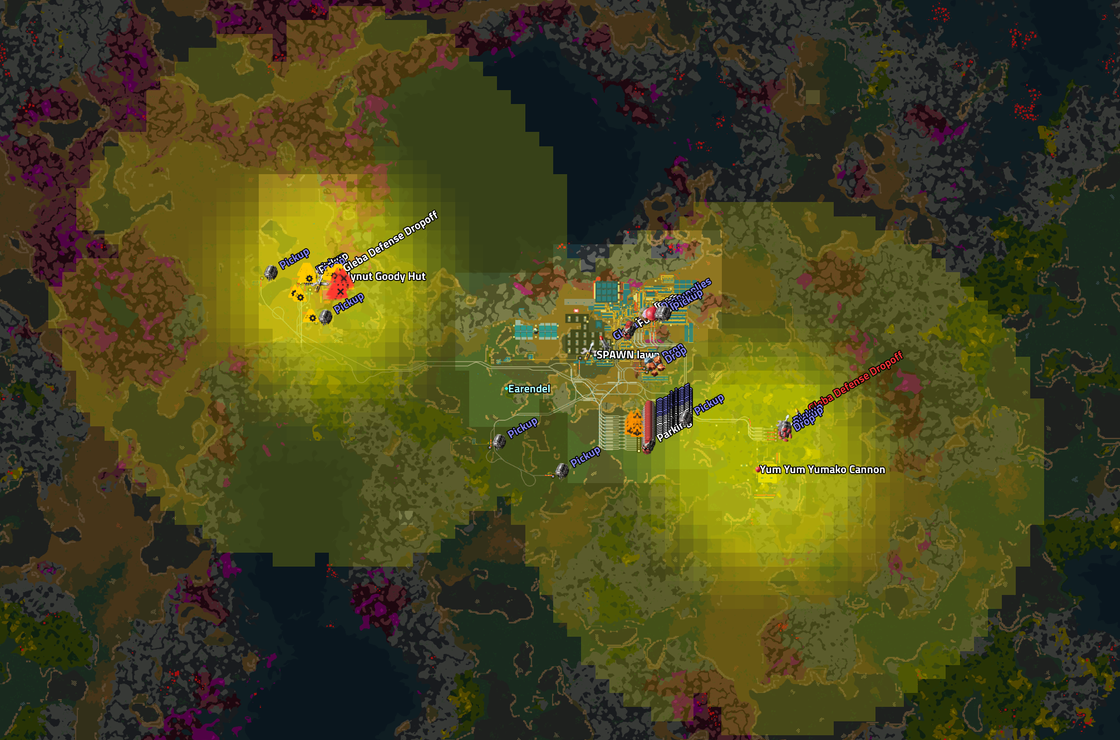 The cloud of spores & pollen. Smells like meddling.
The cloud of spores & pollen. Smells like meddling.
Egg rafts are the pentapod equivalent of spawners. They only appear in shallow waters of the various Gleba marshlands, which both you and your enemies can wade through. This keeps them away from the drier highland areas which are easy to build in, but puts them close to the areas where you want to harvest your agricultural products.
Destroying an egg raft will yield some of the pentapod eggs it contained. Pentapod eggs are a key ingredient needed to make the Biochamber - an important bio processing machine on Gleba. Make sure to use the eggs quickly though. Like many biological items on Gleba they're on a timer, however, they don't "spoil" in the normal way. Wait too long and you may find yourself face to face with a hungry hatchling pentapod...
You will need quite a few biochambers in your time on Gleba. More importantly though, Gleba might need more biochambers when you're not there. So, of course, just automate everything. With a bit of technology you can turn a limited egg supply into a fully automated but somewhat risky production cycle.
Wrigglers are not very threatening individually. The damage from their claws is reasonable, but they are very fragile and tend to die quickly to most weapons in your arsenal.
Their true advantage is in overwhelming numbers. Both Stompers and Strafers can deliver newborn Wrigglers straight to you. When you are faced with a large threat like a Stomper it is easy to overlook the steady accumulation of seemingly weak wrigglers, and before long they can become a viciously deadly horde.
Strafers are fairly fragile but use range and speed to outmanoeuvre opponents. They launch flying wrigglers at their target like a homing missile. When a flying wriggler hits the target it falls to the ground becoming a normal Wriggler ready to keep attacking.
Strafers try to keep their target at a distance and circle it. They outrange the gun and laser turret, so you will need to consider this in your defences. If you place a single turret then a Strafer will be able to destroy it with no consequence. However, if you make a large area of turrets then the Strafer will try to circle the one turret it is fixated on, and while doing so it will probably wander into range of another turret. When they take damage they will try to back away, but they can't change direction instantly so if they go into range of some turrets they might not make it back out.
Ideally you want weapons with long range and/or a high alpha strike, like the rocket turret (which is unlocked on Gleba) or the tesla turret (from Fulgora).
Stompers are extremely tough and can tank a lot of damage. They have a short-range spit attack, but their primary attack is stomping prey with their feet. The foot does a lot of damage with a direct hit, but there's also an area of splash damage when the creature stomps in combat mode. The splash damage means that densely-packed defences take more damage - so sparse networks of defences are more resilient to their attacks. When a Stomper is killed, the young Wrigglers it protects under its shell are released as new opponents.
The Stompers and Strafers can both walk over walls and cliffs, so walling yourself in is not as effective on Gleba. The Wrigglers can't bypass walls once they're on the ground, but that doesn't help when they can be thrown over the wall by a Strafer, or delivered inside by a Stomper.
We knew we wanted many new enemies of very different types. Albert imposed some initial constraints: there should not be anything with fur, and then there should be no vertebrates. My first few designs covered a wide range of directions, so next he added the constraint that things shouldn't get "too alien". So that puts us in the range of designs that approximately look like they could have evolved from an Earth creature thousands or millions of years ago. That's still a huge range of options though, nature can be freaky.
We also knew that at least some of the enemies should be very large. One of the problems with 2D sprites for large enemies is that not only is the sprite automatically larger, but also that for any rotation, a pixel moves more the further it is from the center of rotation. To stop pixels from jumping too much we need more frames to make the rotation smooth, but that's even more pixels for the sprite sheets so large rotating things are doubly bad.
We have some "leggy tech" from spidertrons so it made sense to try to use that on at least one of the new large enemies. That was the starting point for the design that ended up being the pentapods.
There are a lot of different ways you could go with a leggy enemy. At the start we didn't know which enemies would go where so I was sketching all sorts of weird and wonderful things because the design space was so huge. There were a lot of aesthetic and game mechanics considerations along the way, but to give an example: Leggy enemies didn't have pathfinding so they couldn't be on a planet with large obstacles like a lava lake which they can't step over (they actually do have pathfinding now).
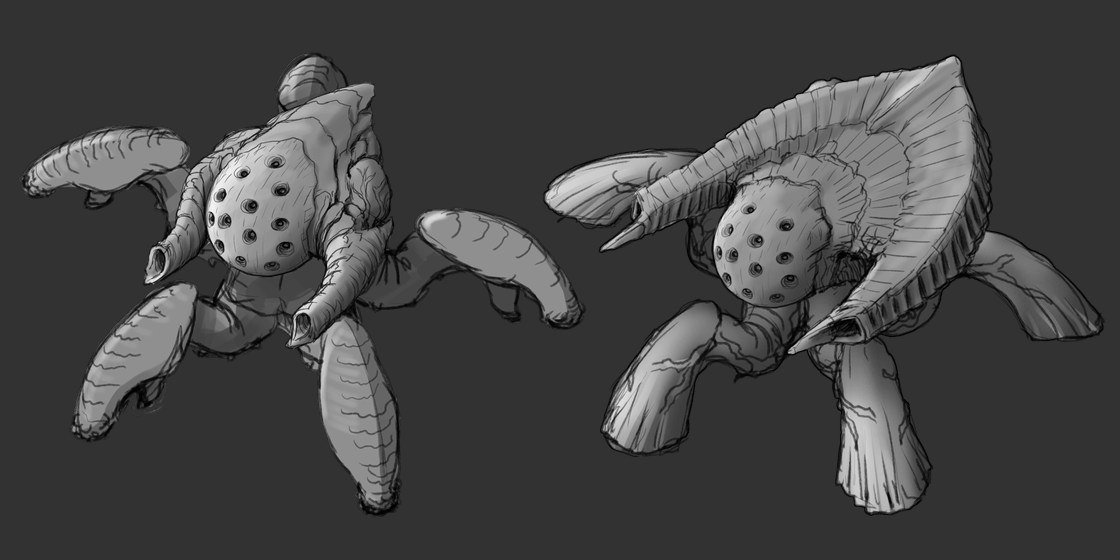 Early Stomper concepts (before settling on starfish ancestry).
Early Stomper concepts (before settling on starfish ancestry).
The pentapods are loosely based on something like seastars being a distant ancestor and then being very heavily evolved beyond that starting point. Seastars have an endoskeleton made up of many small plates and that's really useful for something destined to lift its body off the ground. Seastars are related to Urchins, which have a dome-shaped shell, and that is useful for the 'head' or central body section of the creature.
The legs should be indistinguishable for performance reasons, so that forces some rotational symmetry for the lower body. We found rotation symmetry didn't work for the upper body. For combat it was important to have the enemy clearly show its targeting direction, and that means the 'head' should have directionality to it and look at the target with something like a face.
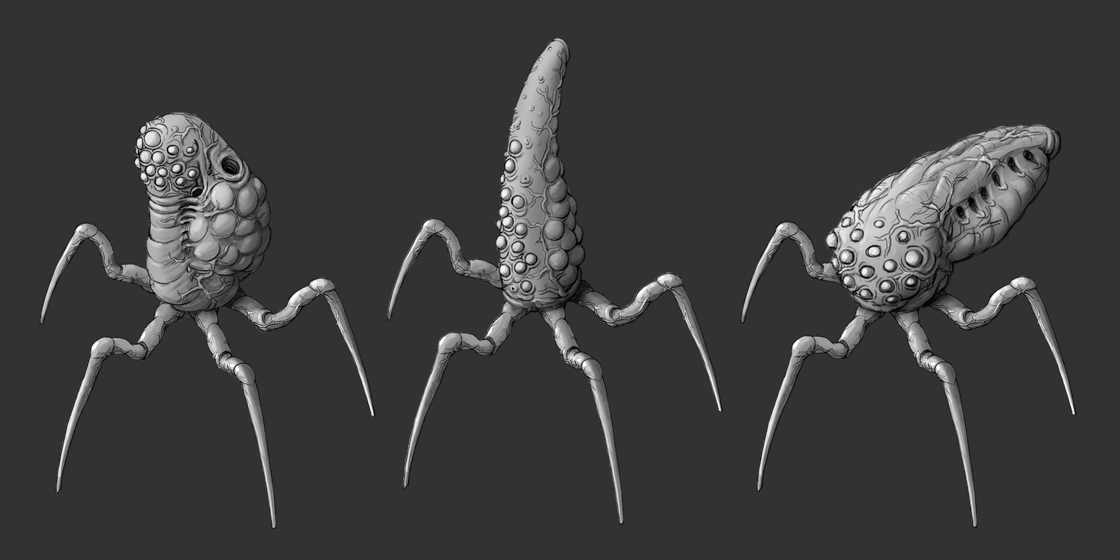 Early Strafer concepts (before settling on starfish ancestry).
Early Strafer concepts (before settling on starfish ancestry).
To do this I designed the head/dome section of the creature to be evolved from a state where it had lots of holes. The holes on one side evolved to be light sensitive and become eyes. The holes on the other side deepened to become more like a sponge to increase air surface area and increase respiration potential. Muscles can squeeze the sponge area to let the creature actively breathe and grow to even larger sizes.
The 'wings' are based on these same sorts of holes but the surface is sealed so it can be inflated with air like a balloon. Originally in the hypothetical evolution process these could have been used as a flotation assistant, but they then would have evolved into inflated crests like a Portuguese man o' war, and then into a shape that helps with gliding and arial control while young. In the Strafer phase of the lifecycle they'd be used as an expressive signalling device, but later in life as the exterior shell hardens the winglets would be lost.
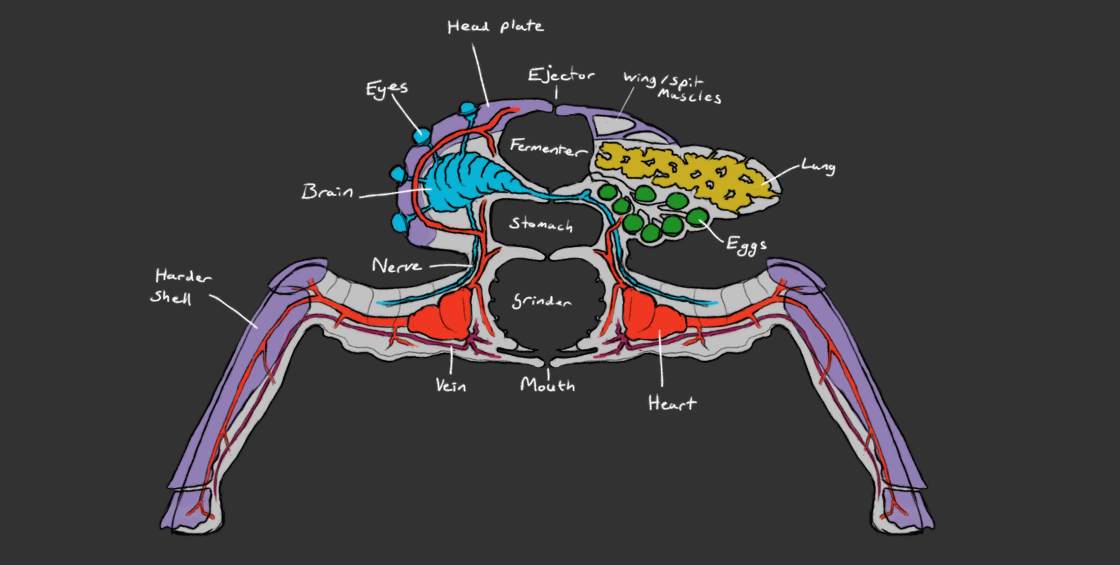 Generalised anatomy of Gleba enemies.
Generalised anatomy of Gleba enemies.
Their mouth is at the bottom of the body. At the top of their head is their multi-purpose hole which is connected to a final fermentation chamber and the last stage of digestion. The creatures produce eggs internally and either spew the eggs into shallow water forming the egg raft, or they keep some eggs to hatch internally where the hatchling can get to the fermentation chamber. The internally hatched young can then be spat out at food sources, or at threats (which are often also food sources) so that they can be grappled and consumed.
 Early flier (missile) concepts.
Early flier (missile) concepts.
In the lore for these creatures, their behaviour, egg incubation strategy, and global population control is linked to them being very tribal creatures where nearby unrelated tribes are considered to be enemies competing for resources. It would be nice to be able to have all of that simulated in the game, but doing so would be terrible for performance and not improve gameplay, so you'll just have to imagine that stuff going on in the background.
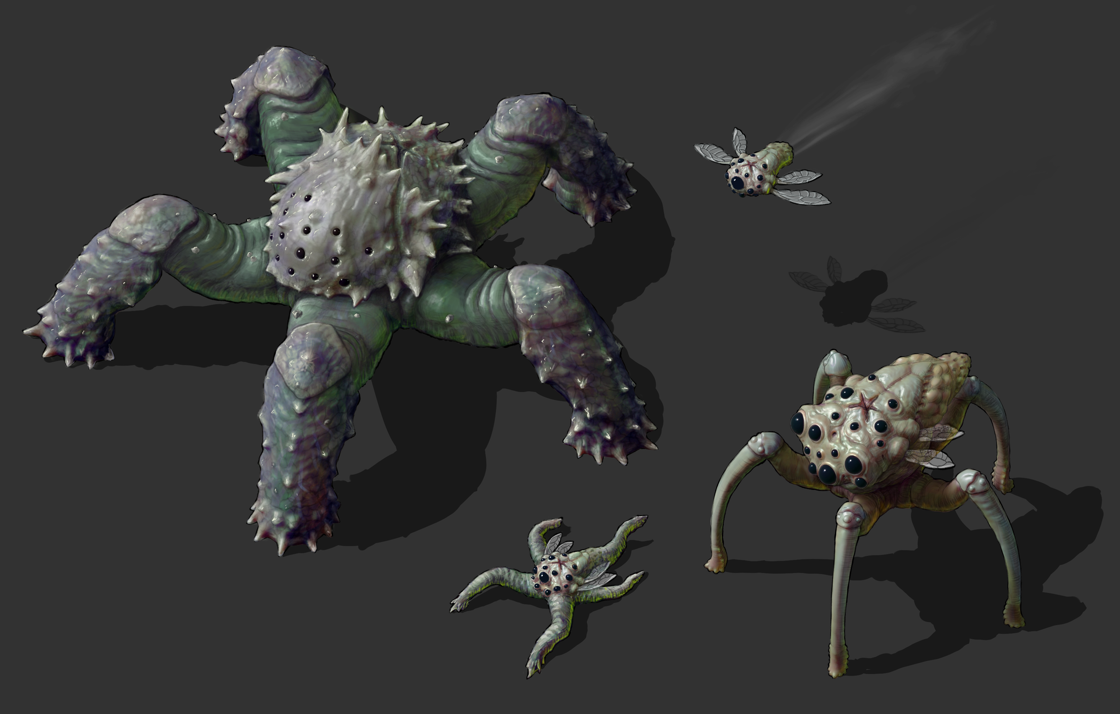 Concept art for the Gleba family.
Initially we were going for more of a translucent look but we couldn't overcome some layering problems caused by transparent overlapped sprites.
Instead we went with rougher shells and rubbery bodies.
Concept art for the Gleba family.
Initially we were going for more of a translucent look but we couldn't overcome some layering problems caused by transparent overlapped sprites.
Instead we went with rougher shells and rubbery bodies.
I created the concept art for all the Gleba enemies, egg raft spawners, and spawning foam with input from Albert and v453000.
Towards the end of the concept art phase I made 3D sculptures of the Stomper and Strafer which were close to the final versions.
From there, Fearghall took the sculptures, added the finer details and texturing, then cut them up for rigging.
At the start we were hoping the graphics could be done in the same way as the Spidertron legs, but of course, things were not so simple. The enemy legs are much thicker and move over a wider range of angles so it revealed all the problems in the old lighting setup. The rigging setup to get both good lighting and good projection angles required some serious mental gymnastics from Fearghall, along with multiple of us trying to help him along the way.
The Wriggler uses classic spritesheets like biters so in most ways that process is a lot simpler, but it does require some hand animation instead of procedural animation.
For these Fearghall gave the models to Jerzy so that he could bring them to life with their iconic wriggles.
As usual, all the sound effects were done by Ian, and music by Petr.
Even though the intention was to just use the systems we already had, we uncovered a range of problems with the old animation systems along the way. Inevitably more work was required on the leggy enemy / spidertron systems to get them working well for this use case. Thanks to a lot of upgrades by StrangePan, we can now have these wonderful creatures and some spidertron improvements too.
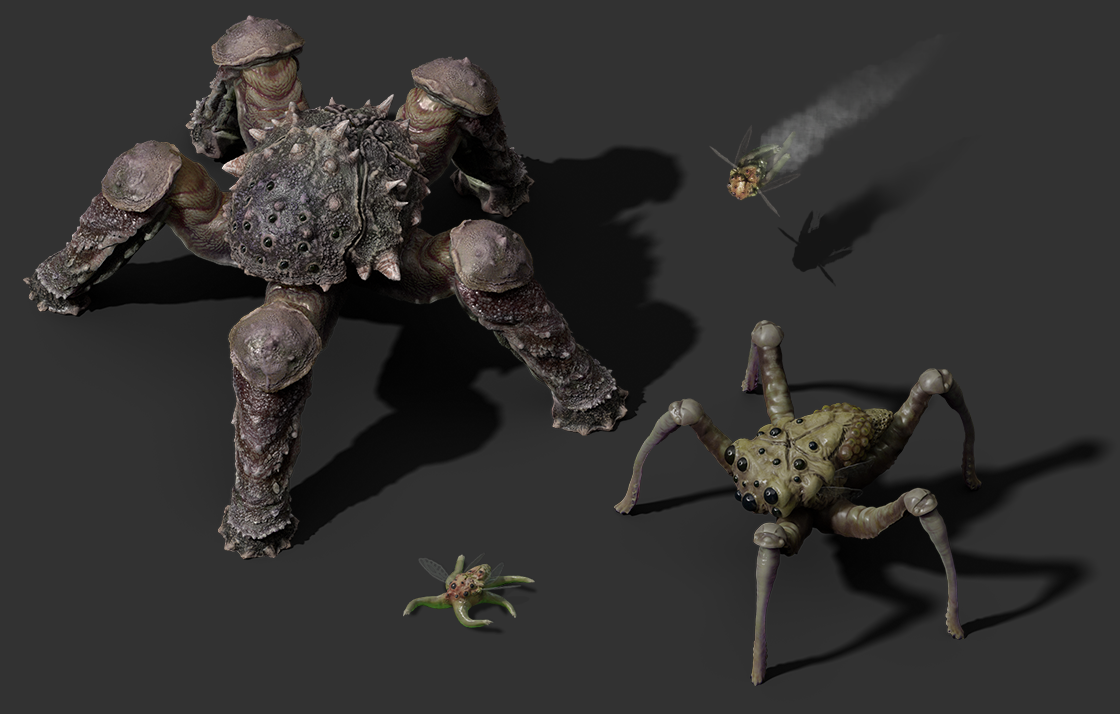 The Gleba family with near-final textures but before the evolution tier tints (Green → Gold → Red).
The Gleba family with near-final textures but before the evolution tier tints (Green → Gold → Red).
The enemies are still subject to change, and some things are still missing like final sound effects for the larger versions.
We also have more combat balancing to do so that combat can be interesting in the right ways and not punishing. Right now they are fun to fight, especially if you're slightly underpowered because it feels like your actions, movement, and target priority matter more. They certainly feel VERY different from biters.
At the moment there are three tiers of pentapod. The combat video only shows the green "small" tier, which are much weaker. The largest tier are especially devastating, but at least in most cases they only trample your agricultural area and not your main processing area so it's easy to recover.
As always, stomp around the usual places and fling your undeveloped thoughts at us.